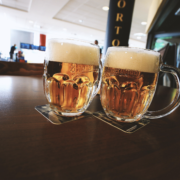In 1948, the annual consumption of beer in the Czech Republic was about 70 liters per year. This statistic rose continuously, and in the 70’s it reached 300 large beers a year.
Since then, it has remained roughly at the same level, although in 2005 there was a record 327 beers a year.
In 2019, the Czech Association of Breweries and Malt (ČSPS) reported that consumption peaked with a total of 142 litres, or 284 pints, drank per capita.
The production also rose by 1.6% in the same year, with Czech breweries alone producing a total of 21.6 million hectoliters of hops.
However, since 2009, the amount of beer sold in pubs, bars, restaurants, and other food establishments has seen a gradual annual decrease.
Other habits have changed over the years. While ten years ago draft beer, the classic ten (or Desítka), was the most sold on the market, lagers have recently dominated, reaching about 60 per cent of the total sales.
The rising popularity of 11- and 12-degree beer continued in 2019, along with the consumption of speciality beer such as wheat, IPA, unpasteurized, and semi-dark beer.
Seasonal limited editions were also seen to be proving popular, such as green lager at Easter while special flavoured lagers, such as caramel, chocolate, and honey took over during the Christmas period.
Czechs are looking more interested in beers produced by mini-breweries, which has been growing rapidly in the last ten years. While in 2010 there were 100 mini-breweries in the Czech Republic, this number has already tripled in 2015, this year there are about five hundred in the country.
“In Europe, we are at the forefront of beer, both in terms of hop production and production volume. In the production of hops, the Czech Republic is just behind Germany in Europe, only the USA is ahead of us in the world,” stated the Czech Statistical Office.
Last year, 51,000 tons of hops were harvested in the United States while Germany produced 48.5 thousand tons. As the International Hop Growers’ Association further stated in its statistics, last year 7,145 tons of were harvested in the Czech Republic, followed by China with 7,044 tons. In fifth place was Poland with 2,900 tons, followed by Slovenia, England, and Australia.
More than half of the Czech production is exported, mainly to Japan.
Non-alcoholic beer continued to be a rising trend in 2019, with a rising number of pubs and restaurants offering draught non-alcoholic beer in both flavoured and non-flavoured variants, along with no-alcohol mixed lager.
This is attributed to health and wellness trends in the Czech Republic, with a rising number of people taking up active sports and following healthier lifestyles.
During the lockdown from March to May, the Czech beer sector’s revenues were down 4.7 billion koruny (€179m) amid a 55 per cent drop in beer sales.
Despite a surge in buying of bottled beer, brewers lost some 1.1 billion koruny (€42m), according to Martina Ferencová, executive director of the Czech Association of Breweries and Malthouses.
Support Prague Morning!
We are proud to provide our readers from around the world with independent, and unbiased news for free.
Our dedicated team supports the local community, foreign residents and visitors of all nationalities through our website, social media and newsletter.
We appreciate that not everyone can afford to pay for our services but if you are able to, we ask you to support Prague Morning by making a contribution – no matter how small 🙂 .




